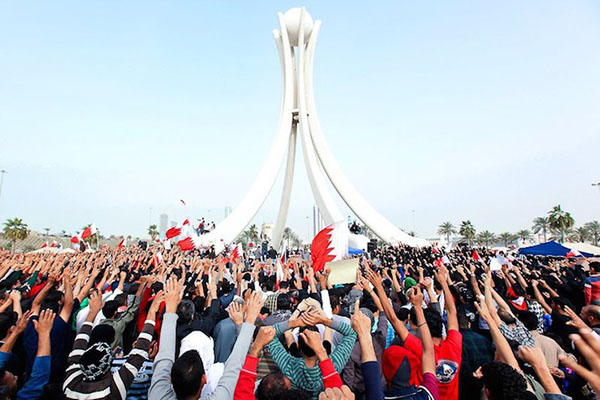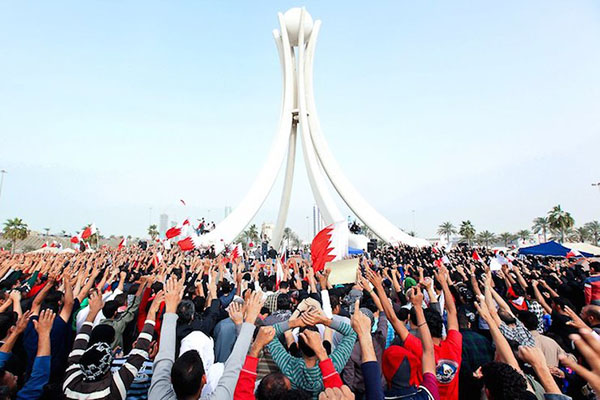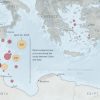
The current Middle East seems to be on the verge of collapse and the revival of the Sunni-Shia divide appears to be the main culprit. The Arab Spring uprisings have altered the existing balance of power and accentuated the sectarian differences in the region. In this context, some states have lost no time in exploiting religious differences to their advantage, and in using sectarianism as a political weapon to pursue political and geostrategic goals. Both Iran and Saudi Arabia have taken the lead in this power politics game, turning the Gulf region into the battlefield of what has been referred to as the “new Middle East cold war.”
Similarly to regional hegemons in the Cold War, and in the Arab Cold War of the 1950s and 1960s, Saudi Arabia and Iran have not engaged in direct confrontation with each other, but have used neighbouring countries as battlefields to settle their rivalries. Given the multicultural, sectarian and transnational identities in the Gulf, the exploitation of the Sunni-Shia divide has become a key tool in the foreign policies of some states. The repression of the 2011 uprising in Manama’s Pearl Roundabout is particularly illustrative, since it involved the use of a sectarian discourse by the governments of both the Al-Khalifa and the Al-Saud.
Although democratic and cross-sectarian in nature, Bahrain’s Arab Spring was immediately depicted as sectarian and portrayed as part of an Iranian plot to overthrow the Al-Khalifa regime and threaten the balance of power in the Gulf. It was perceived both as an external and internal threat to the Gulf Cooperation Council (GCC) states due to the risk of contagion and spillover. Shia-led calls for reforms challenged not only the sovereignty of the autocratic leaders, but also Sunni hegemony in the region, since they empowered both Iran and the Shia communities in the Gulf. Saudi Arabia was the most affected state, given its animosity towards Iran and the outbreak of Shia unrests in its oil-rich Eastern Province.
In order to suppress Bahrain’s February 2011 uprising, Saudi Arabia led the military intervention of the Joint Peninsula Shield Force within a month of the outburst of the protests. It was the first time that the GCC intervened militarily in one of its member states to suppress an internal revolt, as its founding treaty only considers intervention in the case of a foreign threat. Sectarianism made possible the externalization of the threat posed by the Pearl Roundabout uprising, as it was used by the GCC states as a weapon for self-defence. By picturing the revolts as sectarian, Manama and Riyadh delegitimized and silenced Bahraini’s political demands, hence safeguarding the sovereignty of their regimes. And by accusing Iran of participating in the revolts, they triggered a quick response and a joint pre-emptive action by the GCC, thus protecting Saudi and Sunni hegemony in the Arabian Peninsula.
Both Saudi Arabia and Iran have taken advantage of this sectarian discourse to preserve their power in the region. Given the strong ties between Manama and Riyadh, Saudi Arabia has promoted the use of sectarianism in Bahrain (a close ally) in order to protect its own internal political and economic stability (especially in the Eastern Province) and its hegemony in the Arabian Peninsula. Iran has also benefitted from this portrait of the Bahraini uprising. Even though there is no evidence of direct Iranian meddling in the unrest, Iran has made no efforts to deny these claims. In fact, it has strongly criticized Saudi military intervention and has provided media coverage favourable to the protestors. It has done so motivated by the possibility of increasing Shia leverage in the region.
In this cold war context, sectarianism has become a powerful political weapon used not only in Bahrain but also in Syria, Iraq and Yemen. Since rivalries between Saudi Arabia and Iran are played out within the political arena of multicultural neighbouring countries, the exploitation of the Sunni-Shia divide has emerged as much more than a soft power foreign policy tool. However, sectarianism has proven to be a double-edged sword and its overuse is giving rise to important security concerns, as identity is easier to exacerbate than to control. Given the existing transnational identities in the Gulf and the role of sectarian sensitivities in the region, Saudi Arabia and Iran should be more careful when using sectarianism as a means to justify their pursuit of realpolitik interests, since the over-empowerment of identity may end up blurring state boundaries and changing the perception of security threats in the Middle East.


